| The faces of Figs. I and VI are drawn at more acute angles, nearly profile, with the lines of the noses projecting beyond those of the cheeks; the eyes are more intelligent, showing faint irises as well as pupils; while in Figs. III and V extra lines are added below the eye sockets, which give them a fullness quite distinct from all earlier work; the mouths too are more gracefully moulded. Fig. V being shown full-faced is a notable innovation. | |
|
Figure I
Naga-juban-o Kitaru Onna "A Woman in a Naga-juban" May 1920 [Medium] [Large] [Seal] |
These changes in composition go far towards making them life studies of the modern type of Japanese womanhood; and the setting of these isolated figures, on delicately tinted or mica grounds, throws them up more nearly into relief than the absolutely flat presentments which so long held sway. Such developments may be ascribed to the art training of Goyo of whom the following is a brief sketch.
| Return to top |
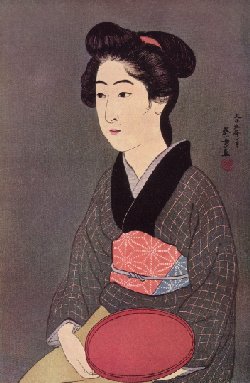
Bon Moteru Onna "A Waitress with a Tray", Jan 1920 [Medium] [Large] [Seal] |
Hashiguchi Goyo, personal name Kiyoshi, born at Kagoshima on December 2, 1880, was the third son of Hashiguchi Kanemitsu, a samurai of Satsuma. In early life he was specially interested in swords and pictures, but it was not till his nineteenth year that he went up to Tôkyô and became a pupil of Hashimoto Gaho the official painter to the Court. Later on he became the head pupil of the Art Association, Hakuba Kwai, at Tameike, and in 1900 entered the School of European Painting at Tôkyô. During his student days, 1903-4, he contributed many illustrations for the monthly magazine Hototogisu, and further applied himself to decorative art designing. In 1907 he sent two oil paintings to the Tôkyô Exhibition, "A Peacock and an Indian Lady" and "Hagoromo," the former of which gained the first prize. |
| Return to top |
| In 1910 he took a summer trip to Beppu, touring among the hot springs and romantic scenery of Bungo, making many sketches as he went, one of which furnished the material for his print of "Yabakei" in rain, but on his way home he was attacked by beriberi which stopped his work for a time. Next year, in 1911, he won the first prize in a poster competition for the Mitsukoshi Department Store, and then confined himself to an investigation of the principles of Nishiki-e, and writing critical articles in Bijitsu Shinpo, the editing of Ukiyo-e, and Ukiyo Fûzoku Yamato Nishiki-e, besides superintending the reproduction of the Hôeidô edition of Hiroshige's Tôkaidô, and Utamaro-shû or masterpieces of Utamaro, for the publisher Iwanami. |
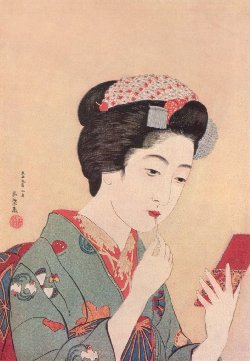
Beni-fude-o Moteru Onna "A Woman with a Beni Brush", Feb. 1920 [Medium] [Large] [Seal] |
| Return to top |
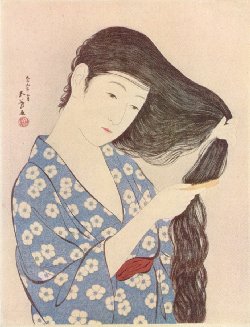
Kami Wo Sukiru Onna "A Woman Combing her Hair", March 1920 [Medium] [Large] [Seal] |
It was not until 1915 that he designed his first colour-print, a "Nude Woman after the Bath," at the invitation of the publisher Shôsaburô Watanabe, which, though only an experiment, gave great promise of after success. A second print dated February 1918 was a "Woman with a Mirror," which was followed by the landscape "Yabakei," a rain scene. The block-cutting for these two pictures he personally superintended in his own home, as also the printing which was done by Kanzo Somokawa, and he was highly gratified with the results of their publication. |
| Return to top |
| In January 1920 these were followed by three more landscapes, "Twilight in Kôbe,'' "The Sanjô Bridge at Kyôto,'' and a very beautiful snow scene "Tarui Yuki no Ibuki-yama," which was limited to one hundred copies published by the Yedo-e Kanshokwai for distribution to the members of that Fine Art Society. "A Waitress with a Tray," Fig. II, here reproduced, is also dated January 1920, a seated figure on a dark mica ground. The bust of "A Woman with a Beni Brush" pencilling her lips, Fig. III, on a pale yellow ground, is dated February 1920, and in March appeared Fig. IV, "A Woman Combing her Hair" on a faint pink ground. |
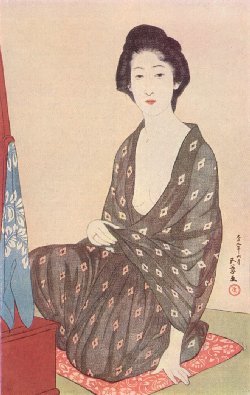
Natsu-mono I No Onna "A Woman in Summer Clothes", June 1920 [Medium] [Large] [Seal] |
| Return to top |
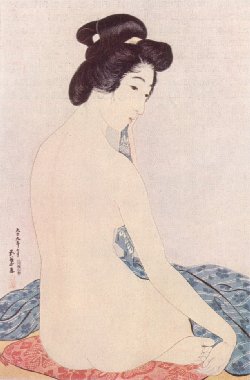
Yoku-go No Onna "A Woman After a Bath" [Medium] [Large] [Seal] |
In May he tried his hand at a new form of composition, a panel print with a full-length figure of "A Woman in a Naga-juban," or gay under-kimono, Fig. I, in which the garment is crêped with blind pressure blocks which do not show in the reproduction. The "Woman in Summer Clothes," dated June 1920, Fig. V, reveals beneath the gauzy material the fleshy form beneath, and has a pale buff ground. In July he reverted to a study of the nude, "A Woman after a Bath," seated wiping her ear, on a mica ground, giving a tone of exquisite softness to the picture. The last print he completed was of a "Pair of Ducks" in water, dated August 1920. These thirteen were all that he was able to finish, being taken ill with otitis media in December from which he died on February 24 in the tenth year of Tai-Shô = 1921 in his forty-second year. |
| Return to top |
|
| Ito Shinsui is one of Japan's living artists who has been designing fascinating prints of young women, and of great variety. Among his finest are the two here reproduced: Fig. VII is that of a nude woman in a bathroom with the steam circulating round her, the outlines of her graceful body rendered by gauffrage on a blue-tinted ground, dated spring Taishô 11 = 1922. |
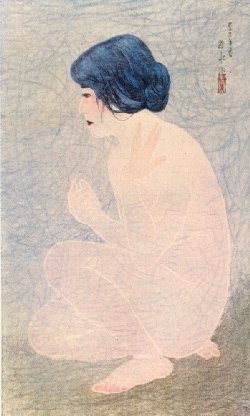
|
|
Figure VII
A Woman in a Bathroom [Medium] [Large] [Seal] |
| Return to top |
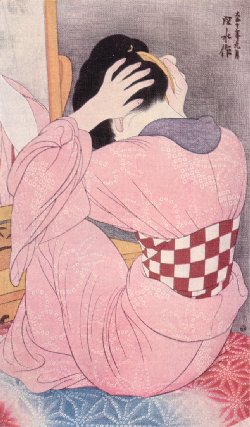
|
Fig. VIII is that of a girl in a pink kimono seated before a dressing-glass, placing a comb in her hair, her back being towards the spectator, dated Tai-Shô 12 = September 1923. Both these prints are very rare, being limited to 200 copies each. |
|
Figure VIII
A Girl Dressing her Hair [Medium] [Large] [Signature] |
Excerpted from an article in Apollo A Journal of the Arts, London: The Apollo Press, 1930. All rights reserved. ![]()
| Return to top |
|
